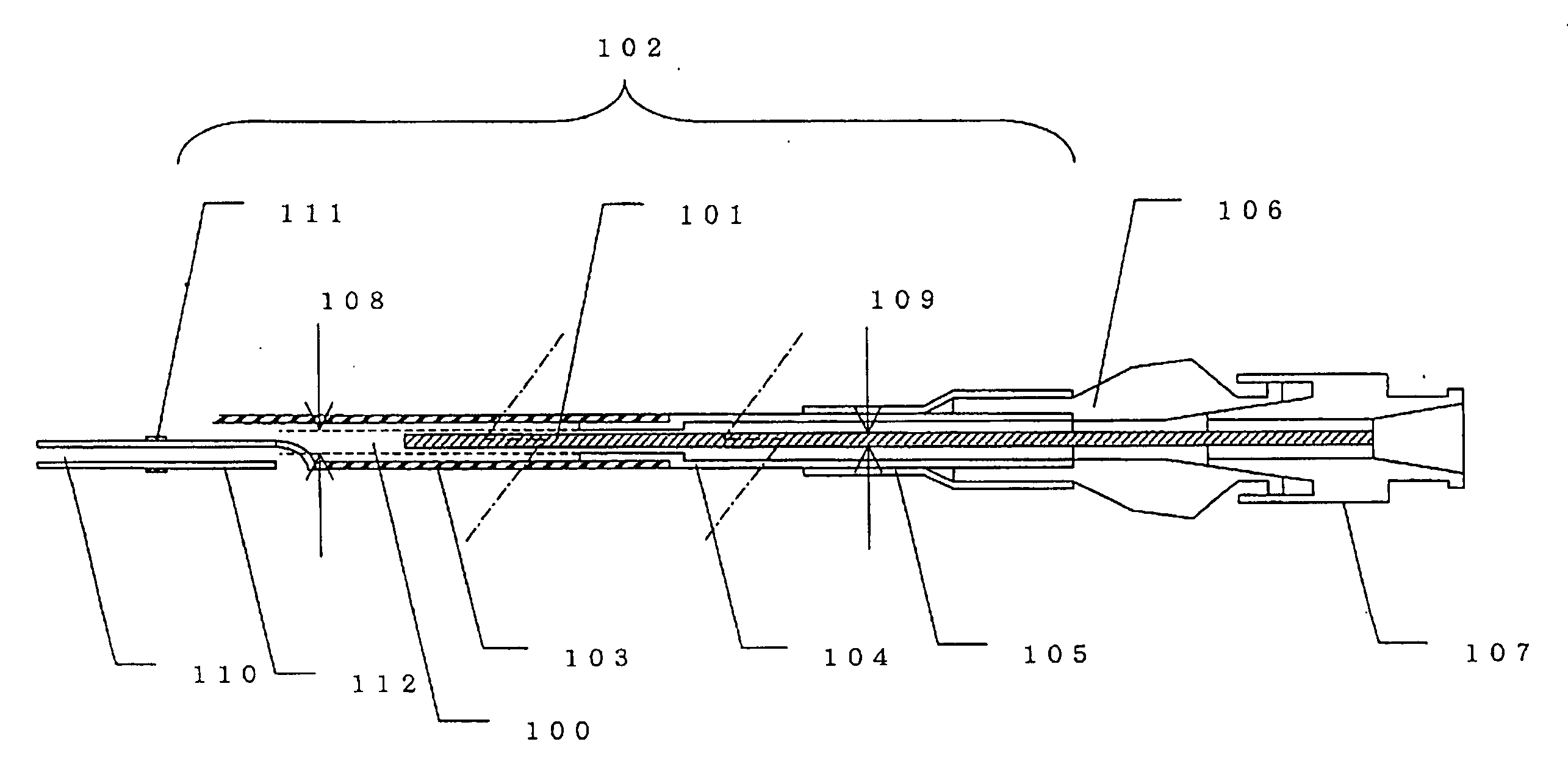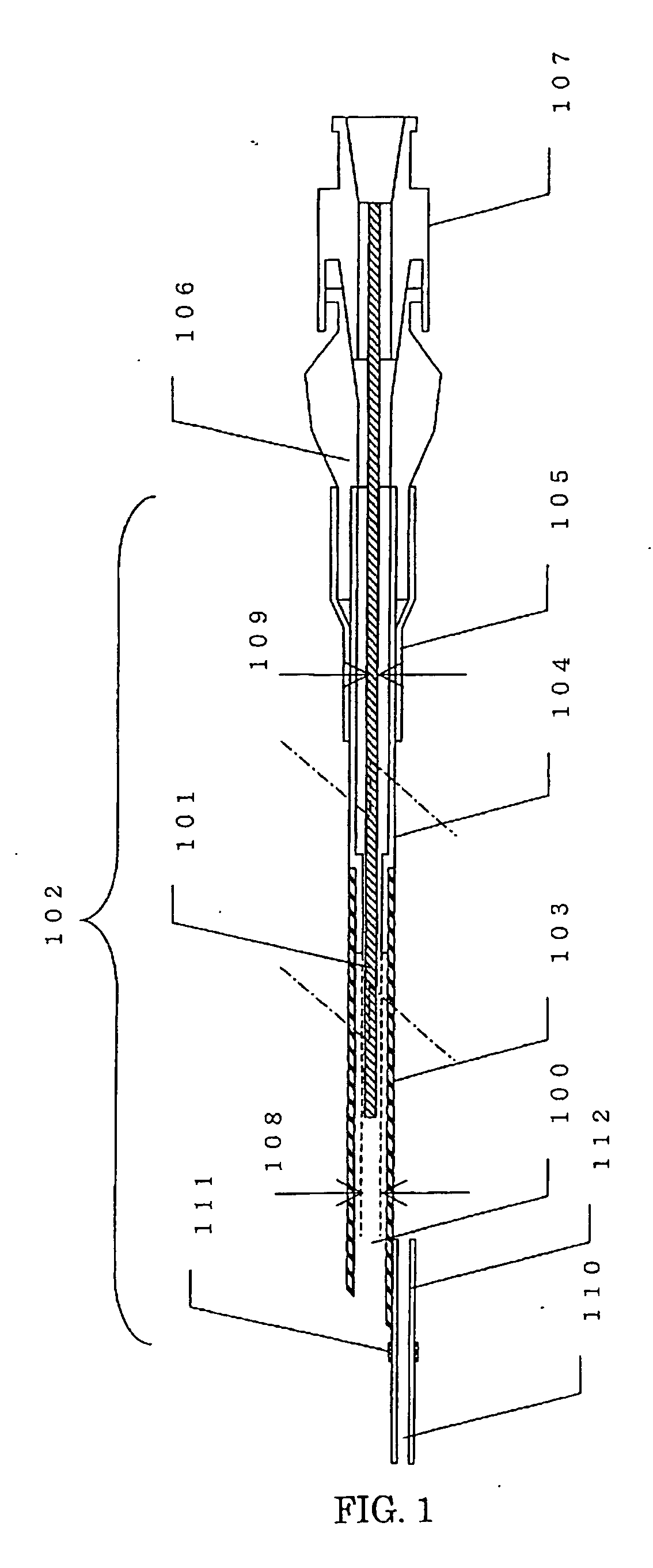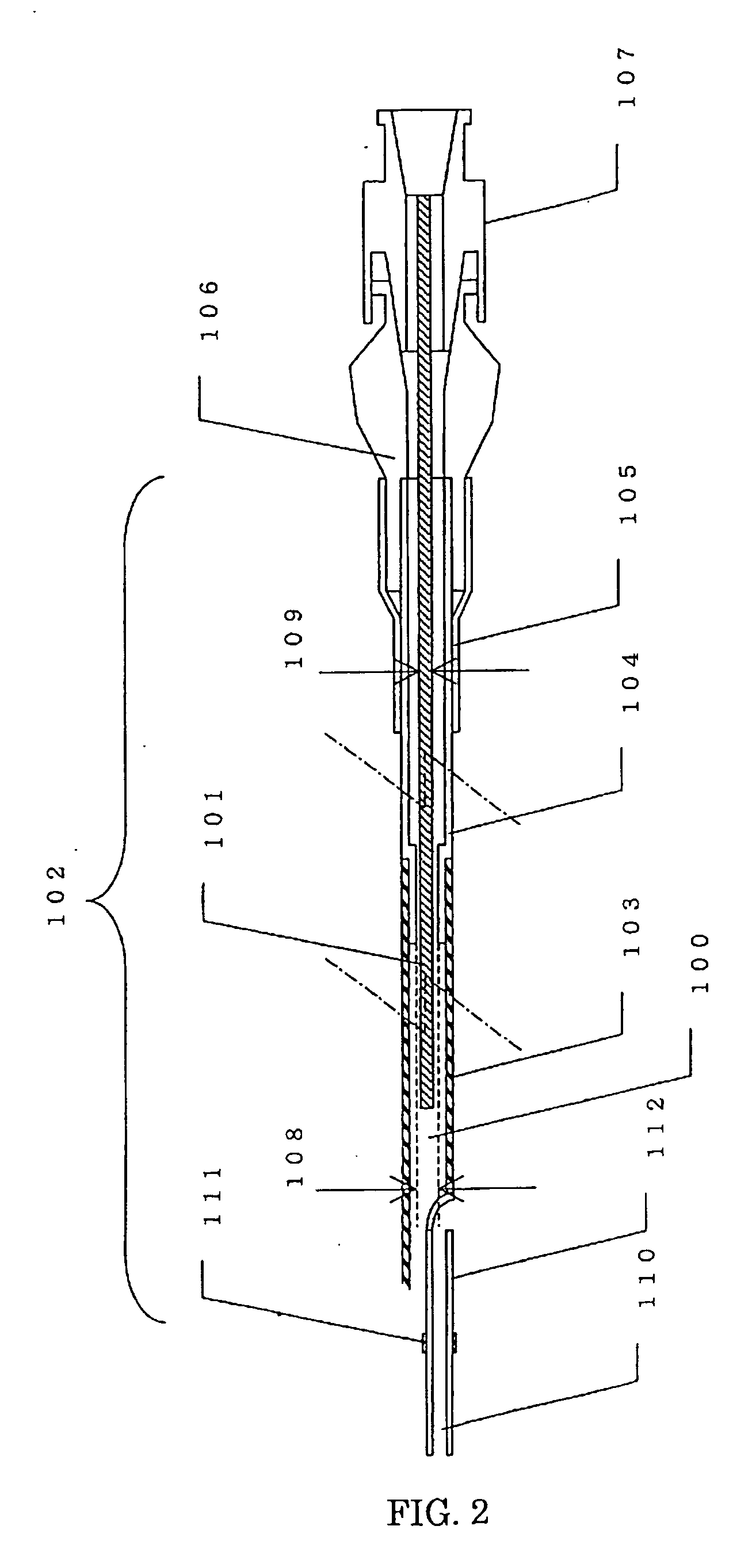[0048] The aspiration catheter of the present invention is characterized by the inclusion of the detachable core wire 101 as described above. The mechanism for allowing the core wire 101 to be detachable is not particularly limited. However, in consideration of operationality during the detachment of the core wire 101, preferably, a connector 107 is fixed on the proximal end of the core wire 101, and the connector 107 is mounted to the proximal end of the hub 106 in a detachable manner. The method for fixing between the proximal end of the core wire 101 and the connector 107 does not
restrict the advantageous effects of the present invention at all, and fixing may be performed using an
adhesive or the like. In such a case, the type of
adhesive used is not particularly limited. The method for connecting the connector 107 to the proximal end of the hub 106 is not limited as long as the connector 107 is detachable. In one preferred embodiment, the distal end of the hub 106 is formed as a female Luer adaptor and the connector 107 is formed as a male Luer adaptor. Thereby, the core wire 101 can be reliably and easily detached. Furthermore, by forming the proximal end of the hub 106 as a female Luer adaptor, it is also possible to simply apply a negative pressure to the aspiration lumen 100 using a
syringe or the like.
[0049] As described above, when the connector 107 is fixed on the proximal end of the core wire 101 and the connector 107 is mounted to the proximal end of the hub 106 in a detachable manner, it is possible to achieve a structure in which the aspiration lumen 100 is flushed through the connector 107. When the aspiration catheter of the present invention is used, it is necessary to flush the aspiration lumen 100 with a suitable solution, such as a solution of physiological heparinized
saline, before
insertion into the body. Flushing prevents
thrombus formation when the aspiration catheter is inserted into the body, in particular, the blood vessels. Flushing is usually performed using a
syringe. Consequently, by forming the proximal end of the connector 107 as a female Luer adaptor, it is possible to perform flushing with the core wire 101 being mounted, and it is possible to insert the aspiration catheter into the body promptly after flushing to start treatment.
[0050] The positional relationship between the guidewire lumen 110 and the aspiration lumen 100 does not
restrict the advantageous effects of the present invention at all. As shown in FIG. 1, the guidewire lumen 110 and the aspiration lumen 100 may be disposed independently of each other. As shown in FIG. 2, the guidewire lumen 110 may be partially disposed inside the aspiration lumen 100. Alternatively, the guidewire lumen 110 may be entirely disposed inside the aspiration lumen 100. However, when the guidewire lumen 110 is partially or entirely disposed inside the aspiration lumen 100, the cross-sectional area of the aspiration lumen 100 is smaller compared with the case in which the guidewire lumen 110 and the aspiration lumen 100 are disposed independently of each other. In particular, an increase in the length in the longitudinal direction of the portion of the guidewire lumen 110 disposed inside the aspiration lumen 100 leads to a decrease in the amount of aspiration. Therefore, the length of the portion of the guidewire lumen 110 disposed inside the aspiration lumen 100 is preferably as small as possible. On the other hand, when the guidewire lumen 110 and the aspiration lumen 100 are disposed independently of each other, there is an
increased risk that the guidewire shaft 112 will be separated from the distal shaft 103 when the aspiration catheter is inserted or withdrawn along a guidewire. It is also possible to reinforce the joint between the guidewire shaft 112 and the distal shaft 103 using another component. In such a case, however, the outer
diameter of the joint significantly increases. As described above, the aspiration ability and safety of the catheter greatly depend on the positional relationship between the guidewire lumen 110 and the aspiration lumen 100. Therefore, it is obvious to those skilled in the art that the aspiration catheter can be appropriately designed in consideration of the
target site to be treated, method for use, required amount of aspiration, substance subjected to aspiration, etc.
[0051] With respect to the material for the guidewire shaft 112, in order to secure good slidability with a guidewire, at least the inner surface thereof is preferably composed of a
polyolefin, in particular, a
polyethylene.
[0052] The method for bonding between the distal shaft 103 and the guidewire shaft 112 does not
restrict the advantageous effects of the present invention at all. Namely, if the distal shaft 103 and the guidewire shaft 112 are composed of materials that can be welded to each other, bonding can be performed by
welding. Alternatively, if the distal shaft 103 and the guidewire shaft 112 are composed of materials that cannot exhibit sufficient
bonding strength when welded, bonding may be performed using an
adhesive. In such a case, the
chemical species in the adhesive used is not particularly limited. For example, a
cyanoacrylate, urethane,
epoxy, or
silicone adhesive is preferably used. The curing mechanism of the adhesive is also not particularly limited. For example, a
moisture-curing, two-part curing, or photo-curable adhesive is suitably used. If the distal shaft 103 and the guidewire shaft 112 are composed of materials having poor adhesion properties, surface treatment may be performed, for example, by
oxygen plasma or
corona discharge, or using a
silane coupling agent, before bonding.
[0053] Preferably, the distal end of the core wire 101 recedes from the distal end of the aspiration lumen 100 in the proximal direction. If the distal end of the core wire 101 protrudes from the distal end of the aspiration lumen 100, there is a high risk of internal injuries during
insertion. Furthermore, after aspiration treatment is performed with the core wire 101 being dismounted, when it becomes necessary to move the aspiration catheter to treat another site and the core wire 101 is mounted inside the aspiration lumen 100, internal injuries due to the core wire 101 are highly likely to occur.
 Login to View More
Login to View More  Login to View More
Login to View More 


